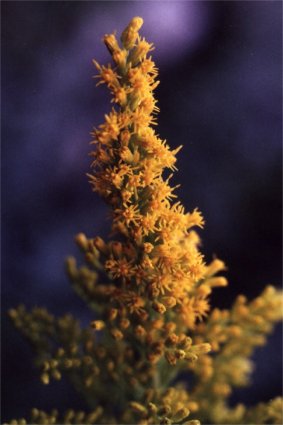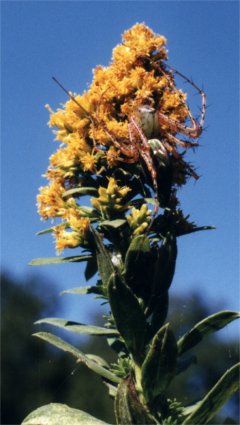Autumn Gold
by Valerie (October 4, 2000)
 
Our fall colors certainly don't rival those in other parts of the U.S., where the leaves of many species of deciduous trees turn brilliant shades of yellow, orange, and red. However, with the cooler temperatures of September and October, many types of flowers begin their annual display and tall goldenrod (Solidago canadensis) is certainly one of the more showy. Large stands of bright yellow blossoms decorate fields and roadsides, with the plants reaching heights of about five feet. If the plants do not receive much water during the summer, they remain rather short and don't fall over, but those that get supplemental water can become top-heavy and arch over in a graceful curve (or in a messy way, depending on your aesthetic ideals). 
I tried to start goldenrod in our gardens from seed, but after a couple of failed attempts, just obtained some small root sections. By the second year, these had grown sufficiently to produce a dozen or more stems each. The plant spreads very efficiently by underground runners and now they appear in the grass as well as the garden. They are rather difficult to pull up since they seem to grow a bit deeper than most other plants. There are many different species of goldenrod occurring throughout the country and the plants have various uses. The flowers were used to produce a dark yellow dye and the leaves can be made into a tea. A common misconception about goldenrod pollen is that it contributes to the outburst of fall hayfever, but this may be because the plant often grows near ragweed, which blossoms at the same time and is one of the prime sources of irritating wind-borne pollen. Actually, goldenrod is not wind pollinated and relies on insects to carry its pollen to other flowers. This fact is not lost on predators like the green lynx spider, who stake out prime blossom heads to wait for prey to happen by. |